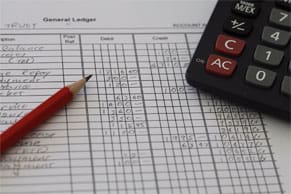The profit and loss (P&L) statement is arguably the most important of the three core financial statements, alongside the balance sheet and the cash flow statement. The P&L includes a business’s revenue, expenses, and net income, among other key financials, for a given accounting period. It demonstrates a company’s results of operations and operational efficiency, which is the ultimate predictor of success. Whether you’re compiling your own P&L or analyzing another business’s, here’s what you need to know.
What Is a Profit and Loss Statement?
A profit and loss statement, formally known as an income statement or simply as a P&L, tracks the amount of profit that remains after a business subtracts all of its costs from its revenue during a specific accounting period, typically monthly, quarterly, and annually. Profit is also referred to as net income or net profit and appears on the last line of a P&L. But between total revenue and net income—each casually referred to as the top and bottom lines, respectively—is other important financial data that not only can help explain business performance, but also identify areas of strength and those in need of improvement. Public companies are required to file their profit and loss statements with the U.S. Securities and Exchange Commission in accordance with Generally Accepted Accounting Principles (GAAP), but even private businesses can benefit from tracking this financial data.
Key Takeaways
- A profit and loss statement includes a business’s total revenue, expenses, gains, and losses, arriving at net income for a specific accounting period.
- Management analyzes a P&L to determine how to increase profitability by increasing revenue, lowering costs or both.
- A P&L is also a useful tool for lenders and investors that are evaluating a business for a loan or investment.
- A profit and loss statement is prepared using one of two accounting methods: cash or accrual.
Profit and Loss Statement Explained
A profit and loss statement demonstrates the results of operations for a fiscal period, reflecting revenue, expenses, and profitability. When revenue exceeds expenses, the result is net income, commonly called profit. The higher its profit, the better the business’s ability to grow, invest in operations, attract financing, receive loans, and reward shareholders. When costs surpass revenue, it’s called a net loss.
A P&L is read top to bottom. Profit is calculated by adding and subtracting various expenses, gains, and losses from a company’s total revenue. The items deducted from revenue are the cost of goods and services (COGS), operating and nonoperating expenses, losses, and taxes. Non-operating income—such as interest income from bank accounts and gains from a legal settlement, for instance—is added to the total amount. The result is the company’s profit or loss.
Only publicly traded U.S. companies are required to file an income statement, quarterly using Form 10-Q and once annually using Form 10-K. Following this data over time, managers can uncover areas in need of improvement and more accurately forecast future financial performance. For example, an unusually high increase in the cost of raw materials over a period may only become evident when a P&L is created.
What Is a Profit and Loss Statement Used For?
A P&L communicates the results of a business’s operations and has many important uses for both internal and external readers. Internally, it’s how management assesses profitability and evaluates performance at various levels within the company. It serves as a primary tool for decision-making, both short- and long-term, by identifying strengths and weaknesses. Through extensive analysis, the P&L guides resource allocation, efficiency tactics, expansion, and cost-cutting. It is also used to set goals and plans for the future, serving as the framework for budgets and forecasts.
External stakeholders use P&Ls to determine whether to lend, invest, or partner with a company, often comparing them with industry benchmarks. Lenders rely on P&Ls to evaluate a company's ability to generate sufficient income to repay loans and calculate key metrics for setting credit limits, such as the debt service ratio. Investors analyze P&Ls to assess the amount and quality of a company’s earnings, scrutinizing various levels of margin and profit. For public companies, investors use net income from the P&L to calculate earnings per share (EPS), a key valuation metric that provides insight into future growth. Partners, both existing and potential, often use a P&L to assess a company’s overall performance and how that performance translates into their individual returns or responsibilities.
P&Ls also play an important role in compliance. They are required for all public companies and must adhere to additional reporting guidance set by the SEC. They are also used for tax preparation for the IRS and are often part of debt covenant reporting packages.
How Profit and Loss (P&L) Statements Work
All profit and loss statements showcase a company’s revenue, expenses, and profit, but they can be prepared using varying levels of detail to fit the intended use. For example, a simple P&L provides a basic summary of financial data for a high-level overview of profits and losses, while a more detailed P&L may include granular data, such as a breakdown of sales and expenses by product line or division. (More on this later.) Also noteworthy: P&Ls often show comparative financials from previous periods—typically year over year—so analysts can compare changes in profits and losses over time.
As noted earlier, a profit and loss statement is one of three main financial statements that are generated monthly, quarterly, and annually. Together they form a full picture of a company’s financial well-being. The other two statement are:
- The cash flow statement, which provides insight to a company’s liquidity, or its ability to meet short-term obligations. More specifically, the cash flow statement lists the amount of cash and cash equivalents that flowed into and out of the business over a specific period from operating, investing, and financing activities.
- The balance sheet, which presents a snapshot of a business’s financial position as of a specific point in time, usually the end of an accounting period. It includes assets, liabilities, and equity.
Basic P&L Formula
The profit and loss statement is based on a simple formula that begins with total revenue from sales for a particular accounting period. Expenses related to operating activities are subtracted, typically leading to a subtotal that shows operating profit. Other income from noncore (ancillary) business activities, such as interest income and gains from non-recurring transactions are added (such as the sale of equipment for more than its carrying value). Similarly, losses related to noncore activities, such as a lawsuit payout, are then subtracted. The final result is net income, which indicates whether the business was profitable.
The basic formula to determine net income is:
Net income = revenue – expenses + gains – losses
For example, let’s say over the course of a fiscal year a business earned $675,000 in revenue from sales and generated a $35,000 gain from the sale of a fully depreciated asset. During that same year, the business had $400,000 worth of expenses—most related to COGS—plus another $55,000 in ancillary losses. Using the P&L formula, net income can be calculated like this:
Net income = revenue – expenses + gains – losses
($675,000 – $400,000 + $35,000 – $55,000)
Net income = $255,000
What the Profit and Loss Statement Shows
A P&L is typically broken into several sections. The top section lists net sales followed by the COGS. The difference between them is called gross profit, and it represents how much money is left after the business has paid all of its direct expenses. Simpler P&Ls may report COGS on one line, whereas others may break it down into specific categories, such as raw materials and labor.
The next section lists all operating expenses, which are the expenses not directly related to the production of goods but are necessary for the business to operate. There is a wide variety of operating expenses, such as staff payroll, rent, legal fees, office supplies, advertising, depreciation, and insurance. These expenses are subtracted from gross profit to arrive at operating income—also referred to as earnings before interest and taxes (EBIT)—which assesses a business’s operating profitability. Managing operating expenses tends to be an easier way to reduce costs than to manage COGS, as COGS has a direct impact on product quality and is dependent on external supplier costs.
Other financial gains and losses are listed next. Gains can include lawsuit settlements in the business’s favor and the sale of assets above their net carrying value. Losses might include lawsuit payouts or property damage from a natural disaster. The result is income before taxes, also known as earnings before taxes (EBT), after which taxes are deducted to arrive at net income. Net income can be distributed to owners, used to pay down liabilities, or retained and used to grow the business.
Components of a Profit and Loss Statement
P&Ls vary not only in detail, but can be tailored to industry nuances and different audiences. For example, P&Ls used for internal management analysis do not need to follow the strict standards required for externally reported P&Ls. Additionally, industry-specific factors influence certain differences to help readers understand better. Accounting in construction businesses will likely have different expense categories than in law firms, for instance, and their P&Ls will reflect those differences. However, some common line items in a business’s profit and loss statement include:
- Revenue: The top line of the P&L is revenue from the sales of goods or services. This amount is net of returns, discounts, and other adjustments made during the sales process (meaning those adjustments have already been subtracted). More detailed P&Ls may show gross revenue and the various deductions to get to net revenue, or they may segment revenue by product or service type, business unit, geography, or other criteria set by the business.
- COGS: The cost of goods (or services) sold includes all the direct costs required to produce products or deliver services. Raw materials, storage costs, parts used in manufacturing, and direct labor costs for production workers are some items that are included in COGS. It may also include depreciation of manufacturing equipment, depending on the accounting method used to create the P&L.
- Gross profit: Gross profit, also known as gross income, is calculated by subtracting COGS from revenue to reveal profitability from a business’s core operations. Positive gross profit is essential for viability as it provides the funds needed to cover operating expenses and taxes.
- Operating expenses: These are the costs to run a business that aren’t involved in the production of a good or service. Operating expenses, such as selling, general, and administrative expenses (SG&A), include corporate office utilities, rent, sales salaries, marketing, and shipping to customers.
- Earnings before interest and taxes (EBIT): EBIT, also called operating income, is calculated by subtracting all operating expenses from gross profit. EBIT is a crucial profitability measure used to show the income from a business’s core operations. It’s particularly valuable when assessing the quality of earnings, as it focuses on the sustainability and repeatability of a company’s core business performance. This is because it excludes the effects of financing decisions, non-recurring gains/losses, and tax strategies.
- Non-operating expenses: These are miscellaneous expenses and one-off losses outside of the business’s core activities. Examples include interest payments, losses on asset sales, restructuring costs, and lawsuit payouts, all of which impact income and cash flow.
- Earnings before taxes (EBT): EBT is determined after all gains are added to and losses are subtracted from EBIT. EBT is a useful measure for comparing similar businesses’ performance since it excludes distortions from differing tax jurisdictions.
- Net income: Net income is the last line of the P&L—calculated after taxes are deducted. This “kitchen sink” calculation is often the first place that investors and lenders look to assess a company’s fiscal health.
- Earnings per share (EPS): For public companies, EPS is calculated by dividing net income by the number of shares outstanding. Investors use this figure to help decide whether they want to invest in a company.
Types of Profit and Loss Statements
A profit and loss statement typically follows one of several common formats, the choice of which depends upon the size of the company, complexity of business operations, and reporting requirements. It’s important to choose the right type of P&L that accurately reflects business operations, provides sufficient information, and meets reporting requirements. Some common types of P&Ls are:
- Single-step: A single-step profit and loss statement reports all revenue items in one group and all expenses in another group to arrive at net income in a single calculation.
- Multistep: A multistep profit and loss statement is more detailed and contains separate sections for operating and non-operating activities. It also includes intermediate totals—such as gross profit, operating profit, and earnings before taxes—to provide more granular insight at each step of operations.
- Condensed: A condensed profit and loss statement can be thought of as a hybrid of multistep and single-step statements. It summarizes the most important line items and often combines less significant categories. The level of detail can vary, but it’s generally less comprehensive than full multistep, but it only required one calculation to get net income. Additional details are often included in supplemental reports instead of on the P&L itself.
- Common-size: A common-size statement converts every line on the profit and loss statement—regardless of the type of P&L used—into a percentage of total revenue for easier side-by-side comparisons with other businesses. This isn’t required by GAAP, but rather is used internally for managers’ analysis or externally to compare different companies.
However, one of the primary differences among profit and loss statements isn’t detectable just by looking at the statements. Rather, it’s recognized by analyzing the methodology used to create them—the cash method versus the accrual method, which can have a big impact on how and when profit is measured. GAAP-compliant financial statements will disclose the accounting methodologies used in the footnotes to the P&L. Here’s a quick overview at how each affect P&L statements.
Cash Method
The cash method recognizes revenue and expenses when cash is received from customers or paid out by the business, regardless of when a sale was made or the bill was received. This method is the simpler of the two and is primarily used by smaller, private businesses, but it’s not GAAP-compliant.
Accrual Method
Public companies are required to use the accrual method, per GAAP, in which they record revenue when earned, even if the customer buys on credit and does not have to pay their bill until a later date. This concept, known as revenue recognition, tends to provide a more accurate view of a business’s operations because it bypasses the impact of payment timing that can muddy the view of when a business is actually conducting its core function—selling its goods or services. Similarly, expenses are recognized in the same period as incurred and COGS are recognized in the same period as the applicable revenue—this is known as the matching principle. For example, advertising expenses incurred in the third quarter are recognized then, regardless of when they are actually paid.
Profit and Loss Statement Examples
Below are three sample profit and loss statements, all for the same accounting period for fictional company “Mike’s Music Shop Inc.” The first is an example of a single-step P&L, the second a multi-step P&L, and the third a condensed P&L.
Single-Step Profit and Loss Statement
Mike's Music Shop Inc
Profit and Loss
Statement
For the Year
Ended December 31, 2021
| REVENUES AND GAINS | |
| Sales | $750,000 |
| Gain on Sale of Equipment | $7,000 |
| Interest Income | $50,000 |
| Total Revenues and Gains | $807,000 |
| EXPENSES | |
| Advertising | $20,000 |
| Cost of Goods Sold | $350,000 |
| Depreciation | $1,000 |
| Income Tax Expense | $71,200 |
| Insurance | $2,000 |
| Interest Expense | $30,000 |
| Rent | $86,000 |
| Utilities | $5,000 |
| Wages | $135,000 |
| Total Expenses | $700,200 |
| NET INCOME | $106,800 |
Multistep Profit and Loss Statement
Mike's Music Shop Inc
Profit and Loss Statement
For the Year Ended December 31, 2021
| SALES | $750,000 |
| COST OF GOODS SOLD | $350,000 |
| GROSS PROFIT | $400,000 |
| OPERATING EXPENSES | |
| Advertising | $20,000 |
| Depreciation | $1,000 |
| Insurance | $2,000 |
| Rent | $86,000 |
| Utilities | $5,000 |
| Wages | $135,000 |
| Total Operating Expenses | $249,000 |
| OPERATING INCOME (LOSS) | $151,000 |
| OTHER INCOME | |
| Gain on Sale of Equipment | $7,000 |
| Interest Expense | ($30,000) |
| Interest Income | $50,000 |
| Total Other Income | $27,000 |
| EARNINGS BEFORE TAXES | $178,000 |
| INCOME TAXES | ($71,200) |
| NET INCOME | $106,800 |
Condensed Profit and Loss Statement
Mike's Music Shop Inc
Profit and Loss Statement
For the Year Ended December 31, 2021
| Sales | $750,000 |
| Cost of Goods Sold | $350,000 |
| Gross Profit | $400,000 |
| Selling, General, and Administrative Expenses | $249,000 |
| Operating Income | $151,000 |
| Net Other Income | $27,000 |
| Earnings Before Taxes | $178,000 |
| Income Taxes | ($71,200) |
| Net Income | $106,800 |
Download Our Free Profit and Loss Templates
Fill-in-the-blank templates of the three profit and loss examples above can be downloaded here(opens in new tab). They are programmed with formulas to perform automatic calculations each step of the way. Small startup companies may choose to manually create their financial statements — and it’s a decent exercise to gain a foundational understanding of all the components that factor into business success. But as the business grows, preparing its financial statements becomes more complicated, greatly increasing the likelihood of errors. Automated software becomes much more practical and even essential to gather the necessary data and generate organized financial statements in a timely manner.
Reap the rewards of accounting software today

How Can You Analyze a Profit and Loss Statement?
There are many ways to analyze a P&L. In fact, large companies have teams of financial analysts who slice and dice data from the P&L with other internal and external data in order to extract useful information. Two broad ways to analyze a P&L are horizontally and vertically. Horizontal analysis refers to comparing the same line items across different time periods, to look for trends. Vertical analysis looks at the relationship between different line items within the same fiscal period. It’s a best practice to use both ways together.
Some more specific examples of P&L analysis include, but are not limited to:
- Comparing revenue over time periods: This horizontal approach involves analyzing how a company’s revenue changes from one fiscal period to another, such as year-over-year or quarter-over-quarter. It’s useful for identifying growth trends, seasonal patterns, as well as the overall trajectory of the business’s top-line performance.
- Identifying profitability trends: Examining how various profit metrics, such as gross profit, operating profit, or net profit, change over time. It shows whether the company is becoming more or less profitable over time and can help assess the effectiveness of cost management strategies.
- Industry benchmarking: Comparing a company’s financial metrics, especially revenue, expense, and profit, to those of its peers or against industry averages. It’s valuable for assessing a company’s relative performance and competitive position within its market.
- Evaluating EBIT margin: EBIT margin is calculated by dividing EBIT by revenue, expressing the metric as a percentage of revenue. Analyzing EBIT this way allows for meaningful comparisons between companies of different sizes or within the same company over various time periods, especially after significant growth or contraction.
- Assessing net profit margin: Net profit margin is a vertical analysis metric that shows net income as the percentage of revenue that translates into profit after all expenses are accounted for. It’s important for evaluating a company’s overall profitability and how effectively it converts revenue into shareholder’s or owner’s value.
- Segmenting revenue streams: Breaking down a company’s total revenue into its various sources or product lines. It’s useful for understanding which parts of the business are driving growth or decline which informs strategic decisions about resource allocation and business focus.
Common Profit and Loss Management Mistakes
Keeping a company profitable is key to its financial health and long-term success. Yet many businesses fall into common traps that can undermine their financial performance and show up as glaring issues on the P&L. These mistakes often stem from ignoring the fundamentals. Avoid these pitfalls:
- Uncontrolled spending: Companies that fail to implement and adhere to proper budgeting and expense management processes tend to overspend. These unnecessary costs reduce profitability and can create cash flow issues, both of which undermine the company's ability to invest in growth opportunities.
- Neglecting the bigger picture: Focusing too narrowly on short-term financial results without considering long-term strategic goals or broader market trends mortgages a company’s future. It can lead to missed opportunities for sustainable growth, failure to adapt to changing market conditions, a need to rely on lower-quality earnings boosters, and potential long-term financial instability.
- Ignoring cash flow: Accrual-based P&L metrics like revenue and net income is disconnected to timing of cash moving in and out of the business. Overlooking this can lead to liquidity problems, business interruption and even business failure.
How Does a Profit and Loss Statement Compare to Other Financial Statements?
While the profit and loss statement is a key financial report, a full understanding of a company’s financial health requires more than just the P&L. The other financial statements—the balance sheet and the cash flow statement—provide complementary viewpoints of different aspects of a company’s financial position and stability. Taking all of these statements together is essential for comprehensive financial analysis.
- The balance sheet offers insight into the company’s net worth and financial structure. While the P&L shows how profitable a company is during a particular time period, the balance sheet reveals its financial strength and liquidity. It’s important to remember that the P&L’s bottom line—net income or loss—flows into the balance sheet and accumulates as part of equity. Net income increases retained earnings, while a net loss erodes them.
- The cash flow statement further bridges the gap, serving as a critical link between the P&L and the balance sheet. It does this by reconciling the accrual based accounting of the P&L with actual cash movements and demonstrates how a company showing net income on the P&L might still face cash shortages, or conversely, why a company reporting net losses might maintain strong liquidity. The cash flow statement helps analysts assess the quality of earnings and the company’s ability to generate sustainable cash flows by identifying the impacts of operations, investments, and financing activities.
Automate Your Accounting Statements and Reduce Errors With NetSuite
NetSuite Financial Management solutions automate complex financial processes that lead to the creation of a company’s core financial statements, including the profit and loss statement. Real-time data about a company’s financial performance is accurately captured, consolidated, and reported in a timely manner and in compliance with GAAP. NetSuite ERP provides visibility across the company’s operational and financial processes as well as other areas of the business. Profit and loss statements can be generated quickly, whenever they are needed, giving managers the information they need to increase profits, reduce losses, and raise that bottom line.
A profit and loss statement is one of three primary financial statements that all companies should prepare and update on a regular basis, and public ones are required to submit quarterly and annually. The P&L focuses on a business’s total revenue and gains, less expenses, and losses, to determine whether it was profitable for a specific accounting period. If it was, the business will have earnings left over to distribute to shareholders, pay down its debts, and reinvest in the business to grow. This is also a positive sign of financial health to third parties, including investors and lenders. Internally, a profit and loss statement provides managers and decision-makers with insight into a company’s profitability, factoring for a variety of costs and expenses incurred along the way. Using this data over time, managers can spot areas for improvement—such as growing revenue or cost-cutting measures—and more accurately forecast future performance.
Profit and Loss Statement FAQs
What is in a profit and loss statement?
A profit and loss statement (P&L) statement includes a business’s revenue, cost of goods and services sold, operating expenses, interest, taxes, net income and any other gains and losses. Revenue is known as the top line, and net income is called the bottom line.
How often should a company evaluate profit and loss?
Companies typically create profit and loss statements monthly, quarterly, and annually. Analysis is ongoing and often leads to ad-hoc evaluations of components in the profit and loss statements. Some key drivers of cadence are business size, complexity, growth rate, financial stability, industry volatility, and regulatory and compliance requirements.
Can I do my own profit and loss statement?
You can, but whether you should depends on the financial complexities of your business. Even the smallest of businesses that first create their P&Ls manually soon hand the job over to software, noting greater accuracy, timeliness, and speed.
What is profit and loss with an example?
Profit and loss statements come in several forms—condensed, single-step, and multistep—all leading to net income. A condensed profit and loss statement presents summaries of revenue and expense categories. A single-step P&L only requires a single calculation to determine net income. A multistep P&L goes into greater detail about income and expenses than the others. A version of any of these formats that adds a column to convert each line into a percentage of revenue is referred to as a common-size P&L.
What is the difference between a profit and loss statement and a balance sheet?
A profit and loss statement and a balance sheet are two core financial statements that businesses generate monthly, quarterly, and annually. A balance sheet lists a company’s assets, liabilities, and equity at a point in time. A profit and loss statement lists revenue, expenses, gains, losses and net income over the course of a fiscal period.
Do all companies have to prepare a profit and loss statement?
Only public U.S. companies are required to prepare and submit a profit and loss statement with the U.S. Securities and Exchange Commission (SEC) and in adherence to the Generally Accepted Accounting Principles (GAAP). Still, private businesses can benefit from regular preparation and analysis of their own profit and loss reports.
Why is a profit and loss statement important?
A profit and loss statement provides managers and decision-makers with insight into a company’s profitability, factoring for a variety of costs and expenses incurred along the way. Using this data over time, managers can spot areas for improvement—such as growing revenue or a cost-cutting measure—and more accurately forecast future performance. External parties, such as investors and lenders, also turn to a company’s profit and loss statement to determine whether it’s worthy of an investment or loan.









